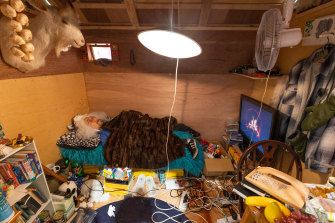
In an art gallery, there’s a little bungalow. And in that bungalow there’s the detritus of a life: old magazines, tins of food, knick-knacks. There are plastic grapes on a side table, a shuttlecock on a shelf, a video of a crackling fire playing on the TV. And in the makeshift bed, a white-haired old man sleeps, his theatrical snores whistling around his man-cave.
This new artwork, commissioned from Jason Phu for the Australian Centre for Contemporary Art in Southbank, could be his imagined home from an uncertain future (the old stuffed man on the bed represents the artist himself).

Jason Phu sits outside his bungalow artwork at ACCA. Credit:Jason South
It’s also home to a tangled web of references. This is a cabin in the woods, that horror trope where something lurks. It’s a microcosm of our isolated lives, our retreat from each other over the pandemic. It’s a place off the grid, a refuge from the ubiquitous digital dragnet. And it’s a meditation on the role of “things” in our lives: the items we hoard and keep about us, ultimately fungible but imprinted with memories only we can access, which make them so hard to throw away while they build into a messy wall around us.
“I’m a bit of a hoarder,” admits Phu, 32. “But I think hoarding comes from a place of nostalgia and love. It also comes from a place of fear, of losing people, and memories, and things – so you try to hold these things.”

Inside Phu’s artwork ‘sleeps’ a stuffed representation of himself as an old man.Credit:Jason South
He points out the shuttlecock: “You might see a shuttlecock over there and be like, ‘Oh, that’s just a bloody shuttlecock I can get for 50 cents.’ But it’s a gift from someone. That’s important to me.”
A lot of the stuff in the bungalow is from his home: “Mum’s wanted me to get rid of a lot of stuff I’ve left in my parents’ shed.” But it’s supplemented with items he’s purchased, adding significance, statues and model animals that reference the animism in Asian culture, the apricots and tinned tuna he loves to eat.
It’s kind of a shrine.
“This is my final resting place,” he muses. “A mausoleum, or a temple to myself.”









 Add Category
Add Category